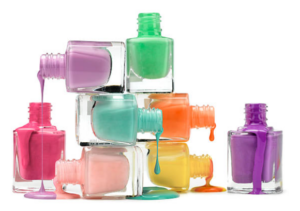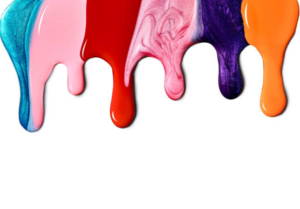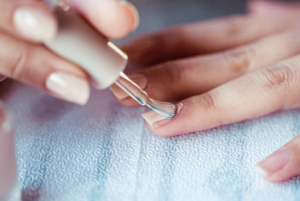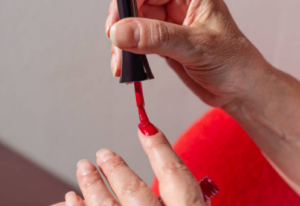The Risks of Formaldehyde, Toluene, and DBP

For many people, nail polish is a staple in their beauty routine, adding a pop of color and a touch of glamour to their everyday look. However, beneath the glossy shine and vibrant hues, there’s a darker side to some nail polishes. Certain products contain toxic ingredients that can pose risks to your health and wellbeing. In this comprehensive beauty blog, we’ll delve into three common toxic ingredients found in nail polish: formaldehyde, toluene, and dibutyl phthalate (DBP). We’ll explore the potential risks associated with these chemicals and provide you with safer alternatives to keep your nails beautiful without compromising your health.
Nail Polish: A Brief Overview
Nail polish has a fascinating history that spans centuries and cultures. It has evolved from its origins in ancient China and Egypt, where ingredients like beeswax, egg whites, and vegetable dyes were used to decorate nails, to the modern-day nail polish we know today.
Nail Polish Formulation
Modern nail polish is a complex beauty product with a formulation that includes various components, each serving a specific purpose:
- Pigments: These provide the color and opacity of the polish. Pigments come in a wide range of shades, from classic reds and neutrals to bold blues and metallics.
- Solvents: Solvents are the liquid carriers that help keep the nail polish in liquid form. They evaporate when the polish dries, leaving behind the colored pigment on your nails. Common solvents include ethyl acetate and butyl acetate.
- Polymers: Polymers are responsible for creating the film that adheres the pigments to your nails. They also help provide the nail polish’s texture and finish. Common polymers include nitrocellulose and acrylates.
- Plasticizers: Plasticizers are added to make the polish flexible and less prone to chipping or cracking. They contribute to the polish’s durability and smooth application. Common plasticizers include camphor and castor oil.
- Additional Ingredients: Nail polish may contain other ingredients to enhance its performance, such as UV filters to prevent color fading, glossifiers for added shine, and thickening agents to adjust the consistency.

The Three Toxic Ingredients
Formaldehyde: The Embalming Chemical
Formaldehyde is a well-known chemical used in nail polish to harden and strengthen the polish, prolonging its shelf life and preventing it from becoming gloppy. However, it’s also a potent preservative used in embalming fluids, which raises concerns about its safety when applied to your nails.
The Risks of Formaldehyde in Nail Polish
Formaldehyde exposure can lead to several health risks:
- Skin Irritation: It can cause skin irritation, leading to redness, itching, and dermatitis.
- Respiratory Issues: Inhaling formaldehyde vapors during nail polish application can irritate the eyes, nose, throat, and lungs, potentially causing coughing, wheezing, and breathing difficulties.
- Nail Damage: Paradoxically, excessive formaldehyde in nail polish can weaken your nails, making them brittle and prone to splitting.
Alternatives to Formaldehyde-Containing Nail Polishes
Thankfully, there are many formaldehyde-free nail polishes on the market today that offer the same level of quality and durability without the associated health risks. Look for brands that explicitly advertise their products as “formaldehyde-free.”
Toluene: A Known Neurotoxin
Toluene is another troubling ingredient commonly found in nail polish. It serves as a solvent to create a smooth, even texture and helps the polish adhere to your nails. However, toluene is also a neurotoxin, which means it can harm your nervous system.
The Risks of Toluene in Nail Polish
Exposure to toluene can lead to several health issues:
- Headaches and Dizziness: Inhaling toluene fumes during nail polish application can cause headaches, dizziness, and nausea.
- Nervous System Damage: Prolonged and repeated exposure to toluene has been associated with nervous system damage, leading to symptoms like tremors and memory problems.
- Reproductive Harm: Toluene exposure during pregnancy can be particularly concerning, as it may harm fetal development and lead to birth defects.
Alternatives to Toluene-Containing Nail Polishes
Many reputable nail polish brands have switched to toluene-free formulas, which are readily available and safe for use. When shopping for nail polish, read the labels carefully and choose products that explicitly state they are “toluene-free.”
DBP: A Hazard to Hormone Health
Dibutyl phthalate, or DBP, is a plasticizer used in nail polish to make it flexible and resistant to chipping. However, like formaldehyde and toluene, it has its own set of health concerns.
The Risks of DBP in Nail Polish
Exposure to DBP has been linked to:
- Hormone Disruption: DBP is considered an endocrine disruptor, which means it can interfere with the body’s hormone system, potentially leading to hormonal imbalances and reproductive issues.
- Developmental Problems: Prenatal exposure to DBP has been associated with developmental problems in children, including genital abnormalities and behavioral issues.
- Allergic Reactions: DBP can cause skin and respiratory allergies in some individuals, leading to itching, redness, and other allergic symptoms.
Alternatives to DBP-Containing Nail Polishes
To steer clear of DBP in your nail polish, choose products labeled as “DBP-free.” Many natural and non-toxic nail polish brands have removed DBP from their formulations to provide safer alternatives for consumers.

Safer Alternatives and Best Practices
Natural and Non-Toxic Nail Polishes
Fortunately, you don’t have to sacrifice beautiful nails for your health. Many brands now offer natural and non-toxic nail polishes that exclude formaldehyde, toluene, DBP, and other harmful ingredients. These polishes are available in a wide range of colors and finishes, ensuring that you can still express your personal style without compromising your wellbeing.
Tips for Safer Nail Polish Application
As awareness of the potential health risks associated with toxic nail polish ingredients has grown, the beauty industry has responded with a wide array of natural and non-toxic nail polishes. These brands have committed to formulating products that exclude harmful chemicals like formaldehyde, toluene, and DBP, offering consumers safer alternatives for vibrant and beautiful nails.
Ingredients to Look For in Safer Nail Polishes
- 3-Free, 5-Free, and Beyond: Many non-toxic nail polishes are labeled as “3-Free” or “5-Free,” indicating that they are free of formaldehyde, toluene, and DBP, and often also free of formaldehyde resin and camphor. Some brands go even further, offering “7-Free” or “10-Free” options, which exclude additional potentially harmful ingredients like ethyl tosylamide and xylene.
- Natural Pigments: Look for nail polishes that use natural pigments derived from minerals and plant sources. These pigments can provide vibrant colors without the need for synthetic dyes.
- Water-Based Formulas: Some brands offer water-based nail polishes that are free of solvents commonly found in traditional nail polish. Water-based formulas are typically odorless and gentler on the nails.
- Vegan and Cruelty-Free: Many non-toxic nail polish brands are also committed to being vegan and cruelty-free, meaning their products are not tested on animals and do not contain animal-derived ingredients.
- Safe Plasticizers: Non-toxic nail polishes may use alternative plasticizers like acetyl tributyl citrate or butyl acetate. These ingredients provide flexibility and durability without the health risks associated with traditional plasticizers.

Tips for Safer Nail Polish Application:
- Ventilation: When applying nail polish, ensure good ventilation in the room to minimize inhalation of fumes. Consider using an exhaust fan or opening windows to promote air circulation.
- Limit Exposure: Try to limit your use of nail polish and nail polish removers that contain toxic ingredients. Give your nails a break between manicures to allow them to breathe and recover.
- Protect Your Nails: Apply a protective base coat before using nail polish. This creates a barrier between your nails and the polish, reducing the risk of staining and damage.
- Choose Safe Nail Polish Removers: Opt for acetone-free nail polish removers, as acetone can be less harsh on your nails and skin. Many non-toxic brands also offer gentle and effective nail polish removers.
- Safe Removal Techniques: When removing nail polish, avoid excessive rubbing, which can damage the nail and surrounding skin. Use a gentle, non-acetone remover if possible, and soak a cotton pad with the remover and hold it on the nail for a few seconds to allow the polish to soften before gently wiping it away.
- Hydration: Keep your nails and cuticles well-hydrated by applying a nourishing cuticle oil or hand cream regularly. Healthy nails are less prone to damage.
Enjoying beautiful nails doesn’t have to come at the expense of your health. Safer alternatives to traditional nail polishes are readily available, offering vibrant colors, long-lasting results, and peace of mind. By choosing natural and non-toxic nail polishes and following safe application practices, you can maintain stunning nails while prioritizing your wellbeing.
Remember that beauty should be a source of confidence and joy, and there’s no need to compromise your health in the process. Embrace the array of non-toxic options available and let your vibrant, beautiful nails reflect your commitment to both personal style and wellness.




